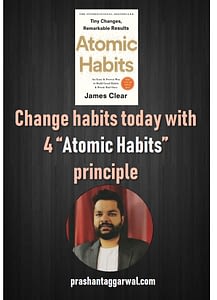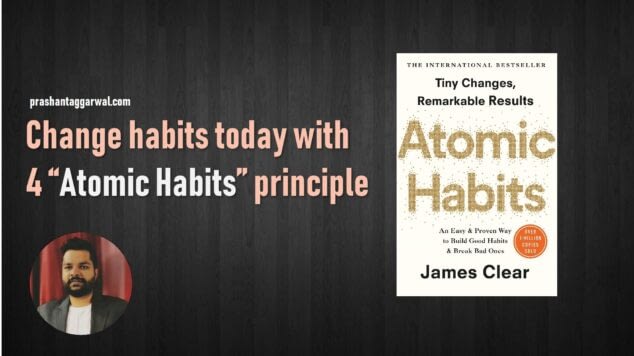
Do you also struggle with changing a bad habit and adopting a new one? If you have trouble changing your habit, the problem is not with you. The problem is in your system.
Well, in this post I’ll be sharing some of the key learnings from Atomic Habits Book by James Clear. It is by far one of the best books I’ve read on habit formation. James clear did a wonderful job synthesizing and condensing the information in a highly digestible and actionable series of steps.
Essentially, a large portion of your daily actions is driven by your automatic habits which are formed through repeated sense throughout the course of your entire life. If they are productive, they will serve you. And if negative, they work against you in either case, you will call them your habit. You are what you repeatedly do. This is the Atomic Habit. It shows how a small adjustment can lead to a massive transformation in your life.
Small Improvements to change habits lead to a Big Impact
It is a small 1% improvement in your life compound to create an astounding effect in your life. If you improve 1% each day, full-year, you will end up 37 times better. By the end of the year, James rightly said that habits are compounding trust of self-improvement. Success is the product of daily habits. Not once in a lifetime transformation. This effect applies to both positive and negative compounding. Imagine typing the seven times better health or 37 times better finances.
Stages of Habit
There are generally four stages.
The cue – First law applies to your cue and it is to make it obvious.
The craving – Second law applies to your craving and it is to make it attractive
The response – Third law applies to response and it is to make it easy
The reward – Fourth law applies to a reward and the aim is to make it satisfying.
Let us now see how to use the habit loop to your advantage, to form some healthy habits.
Now to break any bad habit, we will invert the above process.
1. We make you Invisible
2. We make your craving Unattractive
3. We make the response Difficult
4. We make the response Unsatisfying
The first law says we use the momentum of the old habit we initiate the new habit. For Example – Immediately after my workout, I will eat healthy food. It is the process of attaching a new desired habit to an existing one, which you do automatically.
The second law for building any habit is to make cravings attractive. It is one way to apply your psychology based on the principle, that more probable behavior will reinforce less probable behavior.
The third law is to make it easy. We need to reduce the friction in good habits and increase the Friction to a bad habit. There are two rules for it. Start small, rather than starting with 20 pages. Read two pages per day. If you continue earning 1% each day, then you will find yourself increasing very quickly. Within two, three months, it is important to keep each habit reasonable so that you can maintain momentum and make the behavior easy to accomplish.
Fourth is the law of forming a habit that lasts long is to make it satisfying. In order to ensure continuity, we should understand what is rewarded is repeated and what is punished is avoided. Rewards are crucial to the habit formation process because we need to know which habits are worth keeping.
Start tracking your habit. Most importantly, habit tracking keeps focused on progress, not on end the goal after performing the desire, task. This immediate reward builds a strong enough associates and encourages behavior again and ultimately rewards habit. The idea is to never miss twice.
The Final takeaway is to make the habit obvious, attractive, easy, and satisfying. If we want to build any good habit and reverse the process to break the bad one.
If you found my post useful then do share it with your friends and colleagues. If you have any feedback/questions, you may leave a comment below. I will reply.

